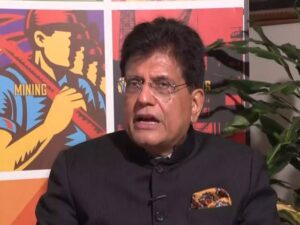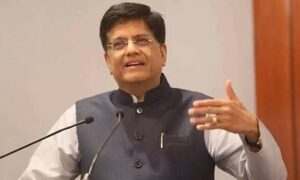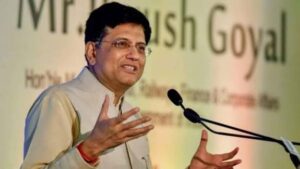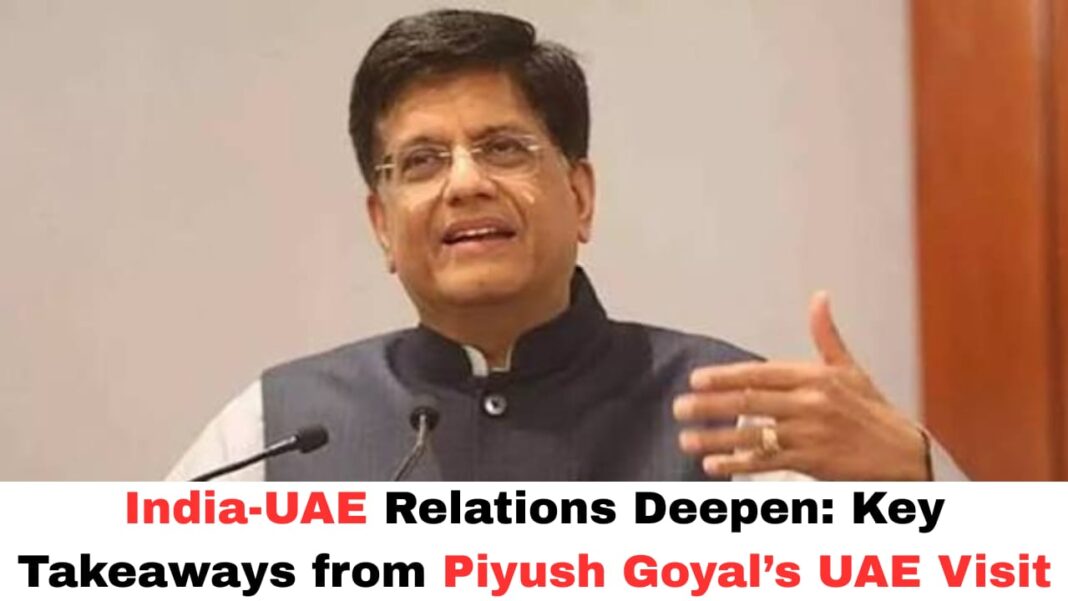Digital News Guru National Desk:
India-UAE Set Ambitious Target: Non-Oil Trade to Hit $100 Billion in 3-4 Years
Union Commerce & Industry Minister Piyush Goyal embarked on a two-day trip to the United Arab Emirates from September 18-19, 2025, for the 13th meeting of the India-UAE High Level Joint Task Force on Investments (HLJTFI). Co-chaired with Sheikh Hamed bin Zayed Al Nahyan, Managing Director of the Abu Dhabi Investment Authority (ADIA), the meeting has set out both immediate priorities and long-term ambitions for bilateral trade, investment, and strategic cooperation.
Agenda: What’s on the Table
The meeting aims to review and deepen several pillars of India-UAE economic partnership:
- Comprehensive Economic Partnership Agreement (CEPA): Assessing progress since its implementation in May 2022. Parties will examine whether its goals are being met and where further work is needed.

- Double Taxation Treaty & Banking/Financial Cooperation: Discussions include refining provisions of the tax treaty, easing regulatory and financial flows, improving cooperation between central banks.
- Expanding Non-Oil, Non-Precious Metals Trade: A key target is to double trade in non-oil and non-precious metal goods to USD 100 billion over the next 3-4 years. Current trade in these categories is estimated around USD 50-55 billion.
- New Sectoral Investment Opportunities: Priority sectors under consideration include textiles (including home decor), fisheries, leather goods, food processing, pharmaceuticals, maritime, aerospace, defence, and space technologies.
- Joint Projects in Third Countries: India and the UAE are exploring collaboration in infrastructure, mining, and housing in third countries. The idea is to leverage India’s human capital and technical expertise with the UAE’s investment strength.
- Facilitating Trade & Investment Infrastructure: Steps to improve ease of investment, regulatory clarity, and setting up mechanisms for smoother business interactions; for instance, placing an Income Tax officer in the UAE embassy to improve tax-information exchange.
What’s New / Major Aspirations
One of the standout announcements is the goal to double non-oil and non-precious metal trade between India and the UAE to USD 100 billion within 3-4 years. This reflects a push to reduce dependence on traditional trade segments (like oil or precious metals) and diversify into more varied sectors.
Another is the strong focus on third-country infrastructure and housing projects, which indicates a shift from purely bilateral trade to outward investment collaboration. With India contributing skills and manpower and the UAE providing capital, this partnership could yield significant regional influence and economic gains.
Also, the sectors being emphasized (textiles, food processing, leather, pharmaceuticals, space and defence) are themselves areas where India has established strengths, so the collaboration could help scale Indian firms’ exports and investment networks.
Challenges & Potential Hurdles
These ambitions are substantial, but several challenges could affect outcomes:
- Regulatory and Policy Barriers: Some sectors, especially defence, space and pharmaceuticals, have strict regulations, licensing, and certification norms that could slow collaboration or limit scalability.

- Infrastructure & Logistics: For trade expansion in non-oil goods, especially perishable items like fisheries, food processing, etc., robust logistics (cold chain, quality standards, transport) are essential. Gaps here can undercut potential gains.
- Trade Costs & Currency Issues: Using local currencies, currency risk, cross-border payment systems, and financial transaction costs matter. Goyal has flagged trade in local currencies as rising, but to make the goal of doubling trade sustainable, these aspects need streamlined implementation.
- Third-Country Project Complexities: Working in third countries (for housing, infrastructure, etc.) means dealing with foreign legal systems, political risk, land acquisition and environmental concerns. Collaboration will need robust agreements and risk mitigation.
Why This Matters
- Economic Diversification
By shifting focus toward non-oil trade and multiple sectors, India and the UAE can build more resilient trade portfolios. For India, this means generating more value from manufacturing, pharmaceuticals, food processing and less reliance on imports or volatile commodity sectors. - Strategic Positioning
With India’s growing global role and the UAE’s status as a financial and investment hub, deeper cooperation strengthens both their positions in global supply chains, investment flows, and influence in third markets. - Job Creation & Technology Transfer
Sectors like pharmaceuticals, aerospace, space tech, etc., have higher value addition. Investment in them will likely involve technology transfer, skill development, and new employment opportunities in India. - Strengthening Bilateral Frameworks
Agreements like CEPA, the Double Taxation Treaty, and regulatory frameworks are the backbone of making ambitious targets feasible. Their successful implementation will send signals of reliability to global investors. - Broader Regional Impacts
Joint investments in other countries (third-country projects) could help expand economic ties beyond bilateral trade—to neighboring regions, Africa, the GCC — amplifying influence and opening new markets.
What to Watch Next
- How exactly India and UAE plan to operationalize the USD 100 billion non-oil trade target: which sectors, which timelines, what policy/enabling infrastructure will be set up.
- Concrete MoUs, investment proposals, or binding agreements in sectors like aerospace, defence, space, pharmaceuticals.

- Whether regulatory changes (customs, quality standards, certifications) are made to reduce friction in targeted sectors.
- Implementation of facilitating mechanisms (like foreign tax officer in embassy, easier investment approvals) and whether they actually reduce red tape.
- Progress in third-country projects: which countries may be involved, the scale, financing, and risk mitigation.
Conclusion
Piyush Goyal’s visit to the UAE and the 13th India-UAE High Level Task Force on Investments meeting mark a pivotal moment in India-UAE relations. The ambitions laid out are bold — doubling trade beyond traditional sectors, expanding into new strategic areas, and extending partnership into third countries. If well executed, the outcomes could substantially deepen economic integration, drive exports, and support India’s growth trajectory. However, realizing these aspirations will require policy coherence, regulatory facilitation, coordination, and a clear roadmap. As the two nations commit to closer cooperation, the world watches to see if these promises translate into measurable gains.
You May Also Read: Mission Shakti 5.0: UP’s Renewed Push for Women’s Safety Starting Shardiya Navratri








